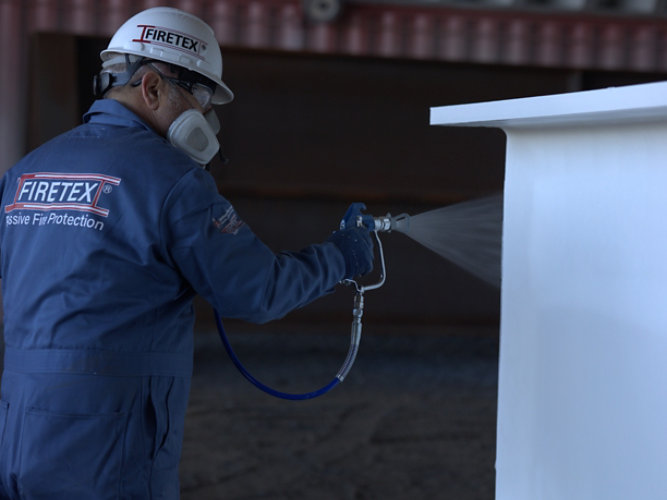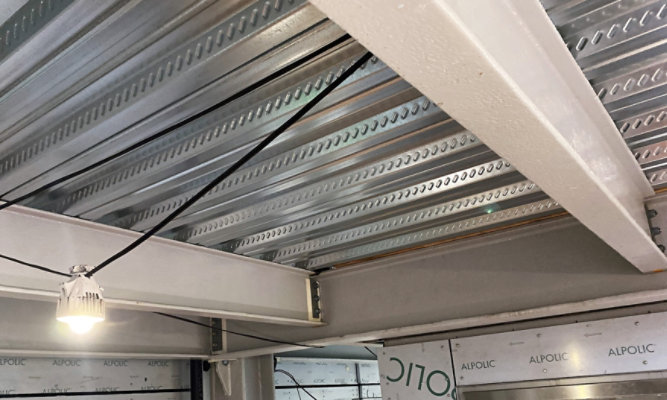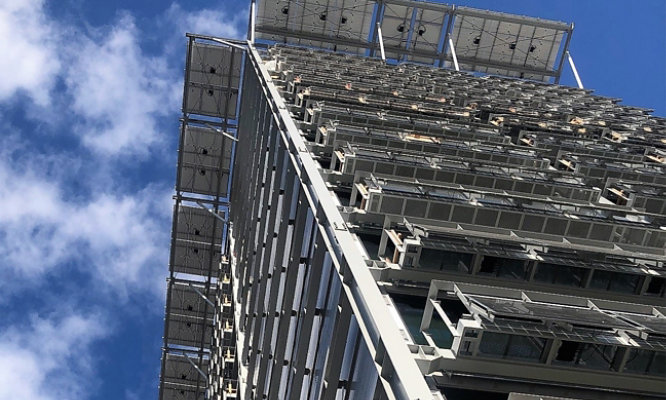A Guide to Intumescent Coatings
by George Guanci, Market Manager – Fire Protection, Sherwin-Williams Protective & Marine
Contact Us for More Information

From skyscrapers and transportation infrastructure to healthcare institutions and universities, facilities across multiple industries are taking advantage of the fireproofing benefits of intumescent coatings.
Intumescent coatings are a powerful tool in passive fire protection that expands and chars when exposed to high heat and flames. With its proven fireproofing abilities as well as its seamless aesthetic appeal, intumescent coating continues to lead the market. Engineers, designers and architects alike trust intumescent coatings to help safeguard lives and protect properties from structural collapse in the event of a fire.
What Is Intumescent Fireproofing?
Intumescent fire-resistant materials (IFRM), known as intumescent coatings or intumescent paint, provide highly effective passive fire protection. They are applied in thin layers to substrate materials such as steel, wood, drywall or concrete and blend flawlessly into existing architecture while supporting structural integrity and occupant safety in the case of a devastating fire.
Definition of Intumescent Coatings
An intumescent coating is a coating that is specially formulated to protect vulnerable and flammable substrates. When in its natural state, intumescent coatings look smooth—just like most other paints. However, when exposed to heat or flames, it quickly expands and forms a char that reduces the transfer of heat from the fire to the underlying substrate, thereby acting as an insulating layer and delaying the time it takes for the structure to fail.
The Purpose of Intumescent Coatings
When load-bearing materials in a building are exposed to flames, they will collapse, potentially leading to devastating damage and loss of life—unless the substrate is protected with a fireproof coating to stave off the flames as long as possible.
The purpose of intumescent coatings is to slow the spread of a building fire, allowing more time for occupants to escape and for first responders to extinguish the fire. Additionally, intumescent coating helps prevent damage and protect the structural integrity of the building itself during an emergency.
Typical Intumescent Coating Lifespan
The lifespan of intumescent coatings depends on several factors, such as the quality of the intumescent product, whether the intumescent coating is exposed to the elements, and how well it is applied. Typically, when maintained appropriately, intumescent coatings can last for several years or even a few decades before they need to be reapplied.
Ingredients Commonly Found in Intumescent Coatings
There are several ingredients in intumescent paint that are responsible for giving the coating its notable fireproofing benefits. While each brand or product will differ, common ingredients include ammonium polyphosphate, melamine, pentaerythritol and titanium dioxide.
Types of Intumescent Coatings
Intumescent coatings are available in three main forms: water-based, solvent-based and epoxy-based.
While water-based intumescent products offer a smoother, more attractive finish, solvent-based intumescent materials are less sensitive to moisture, humidity and temperatures. Epoxy-based intumescent coatings offer advanced durability and extremely strong physical and mechanical properties, making them ideal for areas exposed to high levels of wear and tear or extreme weather.
Intumescent Coating Fire Rating
The ASTM E119: Standard Test Methods for Fire Tests of Building Construction and Materials is designed to evaluate the ability of fireproofing materials to endure fire while maintaining their structural integrity. For example, to become two-hour fire-rated, an intumescent coating must endure fire for two hours before the flames reach the substrate or the structure collapses.
The fire rating of intumescent paint depends on the quality of the product as well as the application process and its resulting thickness. Always check product specifications for more details.
Factors Affecting the Cost of Intumescent Fireproof Coating
The cost of intumescent fireproof coating is based on factors such as the substrate material, the size of the area to be coated, the quality of the product, the cost of labor and how the coating is applied.
When compared to other fireproof coatings like cementitious coatings, the initial price of intumescent paint may be higher. However, cementitious coatings require more coats and therefore increased labor costs. In many cases, intumescent coatings turn out to be the more affordable option.
How Does an Intumescent Coating Work?
Intumescent paint is formulated to react to the heat of a fire. When subjected to a certain temperature, typically around 350‒400°F, the intumescent coating undergoes the process of sublimation, which is when the coating rapidly expands up to 100 times its original thickness and results in a stable, carbonaceous char layer. This char functions as insulation, creating a barrier between the flames and the underlying substrate to slow down the transfer of heat.
By delaying heat transfer, the insulating intumescent coating provides critical safety benefits during devastating fire emergencies—where every second counts.
Application Process: How Is Intumescent Coating Applied?
Intumescent coating is typically applied with spray equipment, which allows for a quick application process and a high-quality finish. Other applications, like brushes and rollers, are also common.
Additionally, intumescent coatings require multiple layers to achieve the desired fire protection. The base layer (primer) adheres tightly to the substrate, the intermediate layers contain the intumescent components that swell when exposed to heat, and the final layer (topcoat) provides added protection and durability.
Step 1: Surface Preparation
The first step is to prepare the surface of the substrate. Any moisture, dirt or other contaminants on the surface can impact the adhesion of the intumescent coating. The surface must be clean and dry, which may require sanding or cleaning the substrate with solvents.
Step 2: Primer
Most intumescent coating products require the application of an approved primer material applied directly to the prepared substrate surface. Steel generally requires a primer, and a primer is recommended for other substrates to ensure the intumescent coating adheres effectively to the surface and properly covers the area at hand.
Once the primer is applied at the appropriate thickness and cured completely, the intumescent coating layers can be applied.
Step 3: Intumescent Coating
After the primer has dried, the intumescent coating can be applied. The number of layers varies depending on the product specifications, desired thickness and intended fire rating—usually, several coats must be applied to reach the thickness required to adequately protect the structure.
The thickness of each coat can range from 30 mils (0.8 mm) to 500 mils (13 mm), and each layer needs to dry fully before the next layer can be applied.
Step 4: Topcoat
When the final layer of intumescent coating has cured, a topcoat layer may be needed.
A topcoat can be selected based on requirements. For example, some topcoats provide additional aesthetic appeal, with a smooth, colorful layer that blends in with the surrounding exposed architecture. Alternatively, an epoxy-based topcoat enhances the durability and strength of the intumescent coating, boosting performance and protecting the structure from environmental conditions.
On-Site vs. Off-Site Application
Fireproof products are traditionally applied on-site, usually in a tent or temporary area, before they are erected.
However, epoxy-based intumescent coatings can also be applied off-site before the steel is shipped to the job site. The steel or other substrate material is coated at an off-site location and then shipped to the job site—already fireproofed—to be erected. This off-site application process shortens the construction cycle, lowers overall costs, allows for superior quality control and results in a more aesthetically pleasing finish than an on-site application.
Shop Industry-Leading Intumescent Fire Protection Coating Solutions at Sherwin-Williams
At Sherwin-Williams, we are dedicated to protecting steel structures and providing life-saving protection from fires. Our line of proven intumescent fireproof coating systems has been specially designed to deliver superior fire protection that meets the highest industry standards and ensures high temperatures do not damage the integrity of steel structures—all without sacrificing aesthetic appeal. Together, we can design a solution that meets the unique specifications of your facility.
To learn more about our intumescent fire protective coatings, contact a Sherwin-Williams representative today.
ABOUT THE AUTHOR
George Guanci is Market Manager – Fire Protection for Sherwin-Williams Protective & Marine. He has more than 40 years’ experience in the construction industry with the better part of that time serving the fireproofing industry. He has extensive experience in both petrochemical and commercial fireproofing and was among the first to promote intumescent epoxy fireproofing technology in the hydrocarbon processing industry. He is experienced and knowledgeable in UL listings and requirements, international fireproofing standards and the development of fireproofing specifications. Guanci is responsible for market management of the Firetex® commercial fireproofing product line in North America for Sherwin-Williams. He is a member of the Construction Specifications Institute (CSI), AMPP and the National Fire Protection Association (NFPA). He holds a bachelor’s degree from Merrimack College and a master’s degree from Northeastern University. Contact: George.M.Guanci@sherwin.com
Discover More
Industry Expertise and Innovation
See how we help customers find customized solutions for their project and application challenges.
Our Fire Protection Expertise
Explore our industry solutions and technology to help protect your assets.
LEARN MOREProduct Lookup
Find out more about our innovative coatings for a variety of industries.
FIND A PRODUCT

